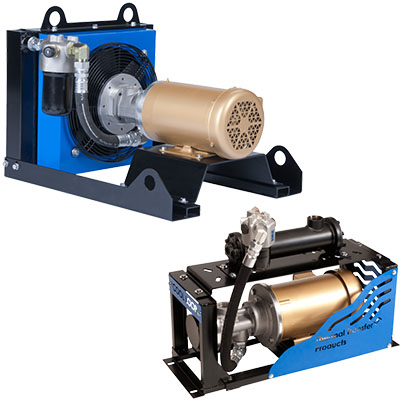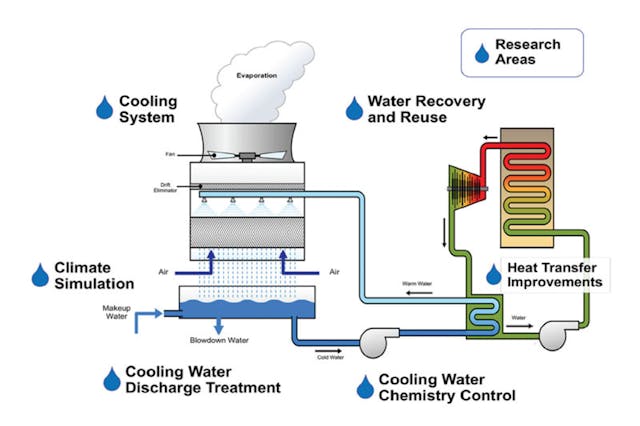Checking out the Perks and Applications of Heat Transfer Systems in Modern Industry
Heat transfer systems play an essential function in modern industry. They encompass numerous systems such as radiation, convection, and transmission, each adding to efficient thermal administration. Industries like manufacturing and aerospace benefit significantly from these systems. As advancements proceed, the assimilation of ingenious products and technologies assures to improve power effectiveness. This evolution increases crucial inquiries regarding the future implications for sustainability and functional costs throughout several fields. What exists in advance in this ongoing improvement?
Understanding Heat Transfer Principles
Heat transfer principles are basic to the operation of numerous commercial systems. These concepts include the devices of radiation, convection, and transmission, each playing a crucial role in taking care of thermal energy. Comprehending conduction involves analyzing exactly how Heat relocates with strong materials, while convection refer to Heat transfer in liquids, driven by liquid motion. Radiation, unique from the other two, involves energy transfer through electromagnetic waves. The efficiency of Heat transfer effects system performance, energy usage, and overall performance. Efficient thermal monitoring is essential in procedures such as home heating, cooling, and Heat recovery. By grasping these principles, industries can enhance their procedures, lower energy prices, and boost devices longevity, consequently adding to a more reliable and lasting industrial landscape.
Key Sorts Of Heat Transfer Equipments
While numerous sectors use Heat transfer systems for varied applications, numerous vital types attract attention because of their specific features and effectiveness. The most typical kinds include radiation, transmission, and convection systems. Transmission systems transfer Heat through direct call in between products, making them effective in solid-state applications. Convection systems, on the various other hand, make use of liquid movement to move Heat, ideal for heating or cooling down gases and liquids. Radiation systems operate without a tool, counting on electro-magnetic waves to transfer Heat, suitable for high-temperature settings. Each type offers distinctive purposes, permitting sectors to customize their Heat transfer solutions based on functional needs, energy effectiveness, and cost-effectiveness. Understanding these systems is crucial for maximizing performance in numerous commercial settings.
Industrial Applications of Heat Transfer Technologies
The application of Heat transfer modern technologies in industry plays a vital function in boosting energy effectiveness and enhancing procedures. DVS Heat Transfer Systems. By executing sophisticated Heat exchange systems, business can substantially reduce their environmental effect while improving overall performance. This combination not just promotes sustainability however additionally aligns with contemporary regulative and consumer needs for greener methods
Power Performance Improvements
As sectors increasingly focus on sustainability, energy efficiency improvements in Heat transfer modern technologies have actually come to be vital for lowering operational costs and ecological impact. Boosted Heat exchangers, for example, use advanced products and layouts to optimize thermal efficiency while reducing power usage. Additionally, integrating variable speed drives in pumping systems permits for far better control of fluid circulation, leading to significant energy savings. The execution of wise sensors and automation offers real-time monitoring, enabling adjustments that enhance power use. Additionally, waste Heat healing systems capture excess thermal power, converting it into functional power. These innovations not only improve energy efficiency but likewise add to an extra sustainable commercial landscape by lowering greenhouse gas emissions and supporting compliance with ecological guidelines.
Process Optimization Techniques
Process optimization methods are essential in improving the efficiency and performance of Heat transfer technologies in industrial applications. These techniques involve refining procedures to maximize Heat transfer performance while minimizing energy usage and operational prices. Techniques such as computational liquid characteristics (CFD) modeling enable designers to analyze and imitate Heat transfer scenarios, recognizing areas for improvement. Furthermore, real-time surveillance systems can offer important information on temperature slopes and circulation prices, making it possible for modifications that enhance efficiency. Executing innovative control methods, such as anticipating analytics, can enhance system responsiveness to differing functional needs. By applying these optimization methods, sectors can attain greater thermal efficiency, reduced downtime, and boosted item top quality, eventually causing boosted competitiveness in the industry.

Ecological Influence Reduction
While commercial Heat transfer technologies are crucial for operational efficiency, their application likewise offers opportunities for significant ecological effect decrease. By boosting energy performance, these systems reduce fuel usage, bring about lower greenhouse gas emissions. For circumstances, progressed Heat exchangers can recuperate waste Heat, rerouting it to preheat incoming liquids, consequently lowering power demands. On top of that, the combination of Heat transfer innovations in renewable resource systems, such as solar thermal and geothermal applications, sustains the shift to lasting techniques. Industries that utilize these innovations also benefit from lowered operational costs and enhanced governing compliance. In general, the strategic implementation of Heat transfer systems not only bolsters productivity however also fosters an extra sustainable industrial landscape, adding to worldwide environmental objectives.
Benefits of Reliable Heat Transfer Systems
Efficient Heat transfer systems offer considerable benefits in modern-day sector, primarily with improved power effectiveness and price reduction. By optimizing thermal administration, these systems minimize power waste, bring about lower operational expenses (DVS Heat Transfer Systems). Businesses can accomplish greater sustainability and enhanced productivity.

Energy Performance Improvements
As markets progressively focus on sustainability and cost-effectiveness, power performance renovations in Heat transfer systems have emerged as a crucial focus. Boosted performance in these systems brings about reduced power intake, making it possible for facilities to operate even more sustainably. By maximizing Heat transfer approaches, markets can lessen waste Heat and attain far better thermal sites monitoring, considerably lowering their ecological influence. Developments in modern technologies such as Heat exchangers and insulation products add to improved efficiency and dependability. Carrying out energy-efficient Heat transfer options not just supports compliance with regulative requirements but also fosters a culture of technology within companies. Eventually, these renovations are essential in lining up commercial procedures with global energy preservation goals, leading the means for a more sustainable future in manufacturing and processing sectors.
Price Reduction Opportunities
By maximizing Heat transfer systems, markets can expose considerable expense reduction opportunities that improve their profits. Reliable Heat transfer decreases power usage, bring about reduced energy expenses and lessening functional expenditures. In addition, boosted system performance decreases the need for upkeep and repair work, additionally saving prices over time. Enhanced Heat transfer can also expand devices life expectancy, enabling companies to delay capital investment on substitutes. Additionally, waste Heat healing systems can transform excess Heat right into functional power, further driving down expenses. These systems not only simplify processes yet also add to sustainability initiatives, placing business positively in a progressively eco-conscious market. Overall, the monetary benefits of reliable Heat transfer systems are necessary and considerable for affordable benefit.
Advancements in Heat Transfer Solutions
How can contemporary sector improve its operations with cutting-edge Heat transfer services? By adopting sophisticated products and technologies, industries can significantly enhance thermal effectiveness and performance. Advancements such as nanofluids, which boost Heat transfer abilities beyond traditional fluids, and stage modification materials that store and release thermal power, are acquiring grip. Furthermore, the integration of smart sensors and IoT gadgets enables for real-time monitoring and optimization of Heat transfer procedures, minimizing waste and enhancing system responsiveness. Moreover, additive production strategies make it possible for the creation of more complex Heat exchangers that make best use of surface location while decreasing product usage. Collectively, these innovations drive operational performance and create affordable advantages in various fields, consisting of aerospace, power, and production.
The Function of Heat Transfer in Sustainability Initiatives
While the push for sustainability proceeds to improve sectors, the role of Heat transfer modern technologies comes to be progressively vital in attaining environmental objectives. Reliable Heat transfer systems promote energy performance by optimizing thermal monitoring in numerous procedures, substantially minimizing energy intake and greenhouse gas emissions. For example, progressed Heat exchangers are site utilized in industrial applications to reclaim waste Heat, thereby decreasing energy waste. Additionally, innovations such as phase change materials improve thermal storage, adding to eco-friendly power combination. The fostering of sustainable liquids in Heat transfer systems can decrease environmental impact. By prioritizing efficient Heat transfer, sectors not just improve functional performance however also straighten with global sustainability campaigns, fostering a cleaner, a lot more sustainable future.
Frequently Asked Concerns
Just How Do Heat Transfer Solutions Effect Energy Costs in Manufacturing?
Heat transfer systems considerably influence energy expenses in manufacturing by improving performance, minimizing waste, and optimizing thermal administration. These improvements bring about lower functional expenditures, eventually benefiting total performance and productivity in commercial operations.
What Maintenance Is Needed for Heat Transfer Solutions?
Maintenance for Heat transfer systems includes regular evaluations, cleansing of elements, checking liquid levels and conditions, replacing used components, and making sure proper insulation. These actions boost effectiveness, extend life-span, and stop costly breakdowns in procedure.
Are There Safety Worry About Heat Transfer Systems?
Safety and security worry about Heat transfer systems consist of prospective leakages, stress build-up, and thermal dangers. Proper layout, regular upkeep, and adherence to safety methods are vital to mitigate these dangers and guarantee risk-free procedure in commercial atmospheres.
Just How Can I Select the Right Heat Transfer System for My Business?
Selecting the right Heat transfer system entails evaluating elements such as performance, application requirements, spending plan constraints, and security criteria. An extensive evaluation of these elements will assist assure ideal performance and dependability in service procedures.
What Prevail Failings in Heat Transfer Equipments and Their Reasons?

Understanding conduction includes evaluating exactly how Heat moves via strong products, while convection pertains to Heat transfer in fluids, driven by liquid activity. By maximizing Heat transfer techniques, markets can lessen waste Heat and achieve much better thermal management, significantly lowering their environmental effect. Waste Heat recuperation systems can change excess Heat into usable energy, better driving down expenses. Advanced Heat exchangers are made use of in industrial applications to redeem waste Heat, consequently minimizing energy waste. Common failings in Heat transfer systems include leakages, rust, and inefficient Heat Check This Out exchange.